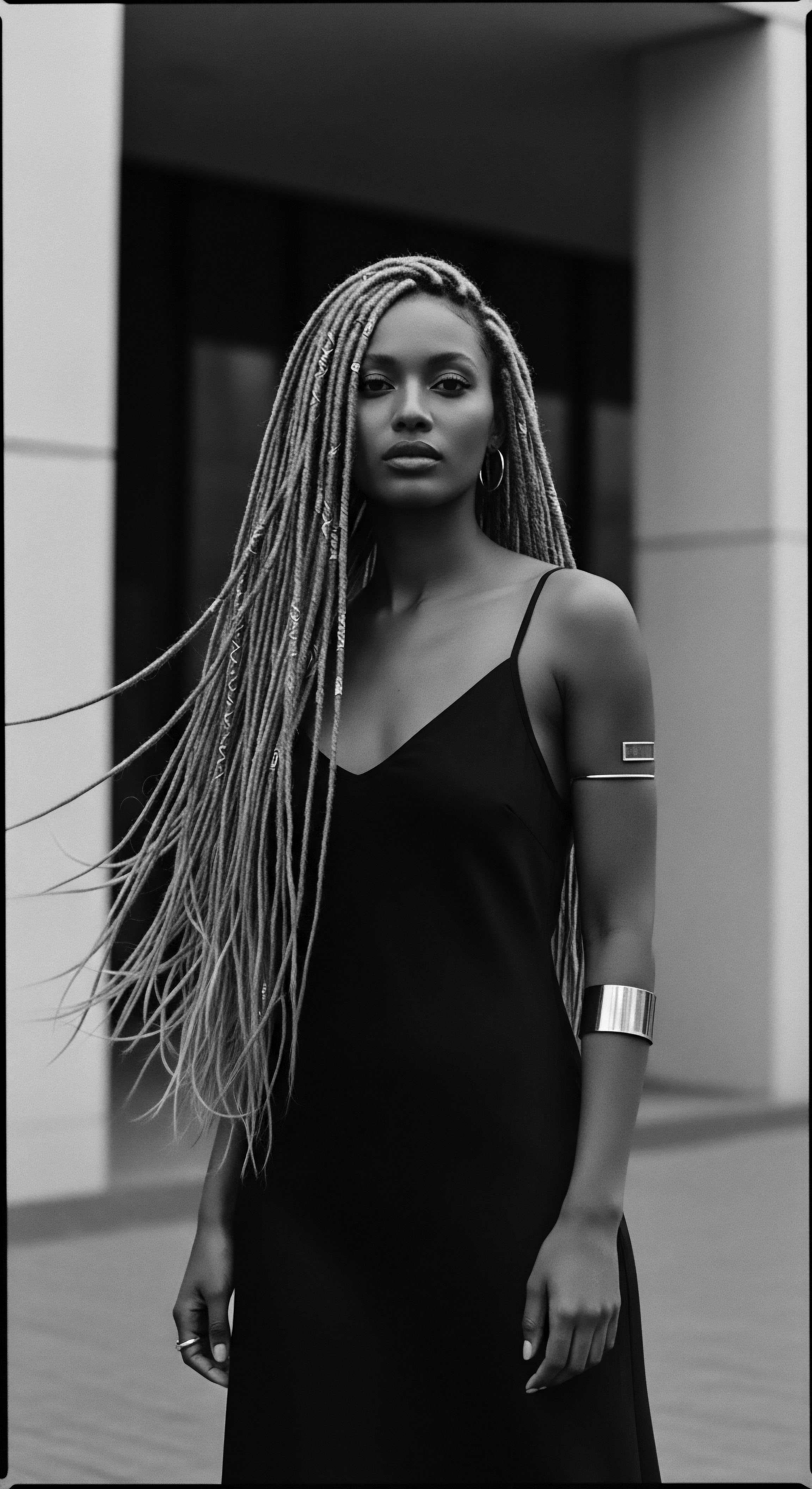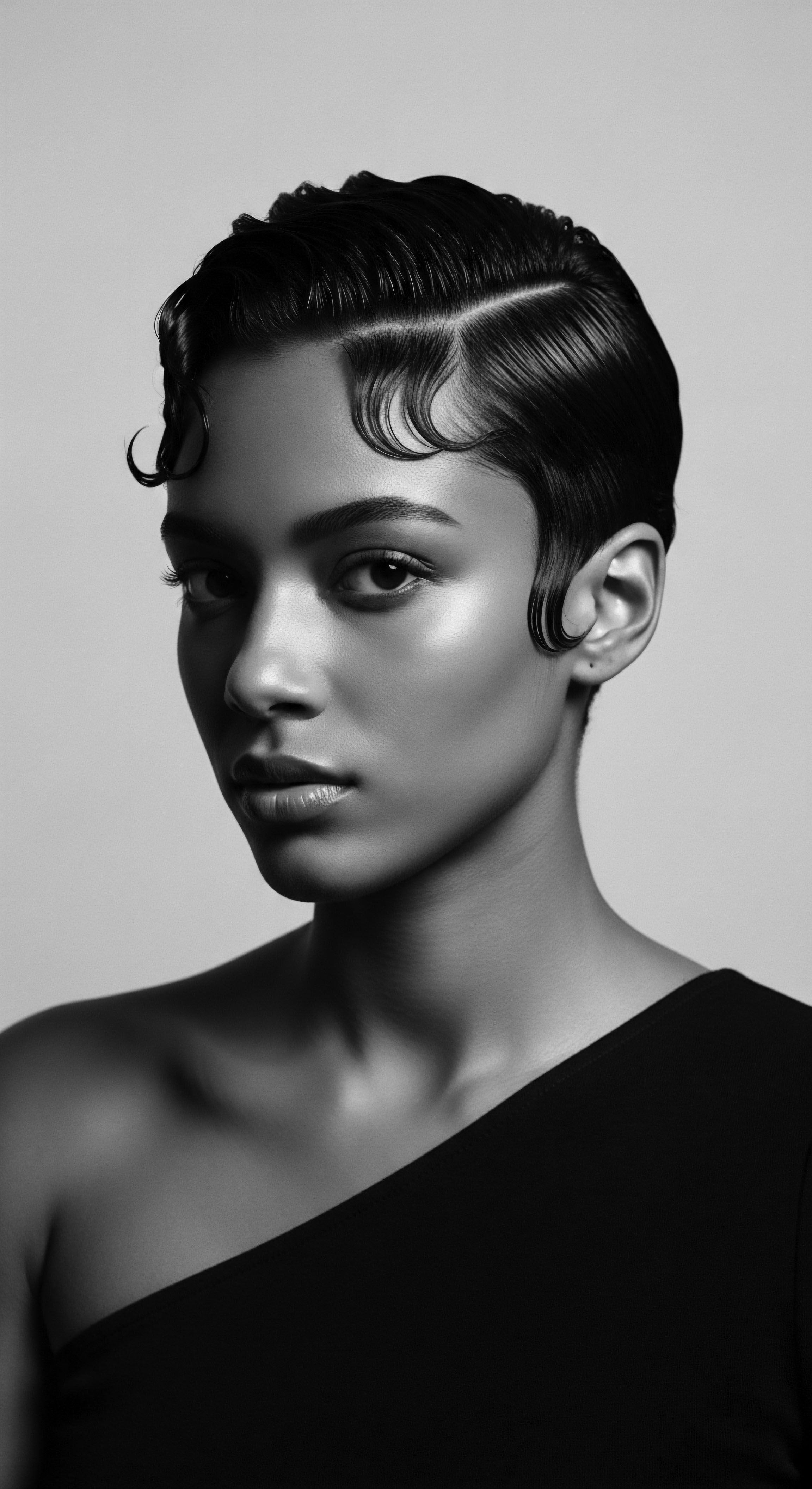The exploration of “Unsaponifiable Constituents” within the context of textured hair heritage is a journey into the very heart of ancestral wisdom, intertwined with modern scientific inquiry. Our path traces the journey from the elemental biology of oils and butters, through the living traditions of care, to their lasting role in voicing identity and shaping futures. This understanding offers a profound connection to the historical practices that have nourished Black and mixed-race hair for generations.

Fundamentals
At its core, the term Unsaponifiable Constituents refers to those components within fats and oils that resist transformation into soap when exposed to alkaline solutions, a process known as saponification. This chemical reaction, foundational to soapmaking for centuries, breaks down the main fatty acid esters, yielding soap and glycerol. Yet, a small, yet mighty, fraction remains untouched. These are the unsaponifiables, a distinct group of compounds that retain their original chemical form through the saponification process.
The distinction between saponifiable and unsaponifiable portions of an oil is crucial. Saponifiable components, primarily triglycerides, are the workhorses for producing soap, contributing to cleansing and emulsifying properties. The unsaponifiable matter, however, holds a unique chemical character. This fraction is typically a small percentage of the oil’s total mass, yet it harbors a wealth of bioactive substances.
These include various types of compounds, each carrying specific properties that contribute to the therapeutic and cosmetic value of the original oil. They are soluble in typical fats and oils but remain insoluble in water following alkali treatment.
Consider, for a moment, the foundational ingredients often found in ancestral hair care practices ❉ shea butter, cocoa butter, and olive oil. Each of these carries a significant proportion of unsaponifiable constituents, which is precisely why they have been so deeply cherished across generations for their benefits to hair and skin. These components are not simply remnants of a chemical process; they are the concentrated carriers of the oil’s most revered qualities.
Unsaponifiable constituents are the resilient heart of natural oils, enduring chemical transformations to impart profound benefits.
Understanding Unsaponifiable Constituents means recognizing that natural oils are not uniform in their composition. Beyond the fatty acids that make up the bulk of an oil, these specialized compounds contribute to the distinctive characteristics of each plant butter or oil. They are the reason certain oils possess exceptional nourishing or protective qualities, qualities long observed and utilized in traditional hair care before modern laboratories could precisely identify their molecular structure.

What the Unsaponifiable Fraction Contains
Within this unsaponifiable portion, one can discover a diverse array of chemical families. These elements, though present in smaller quantities compared to the fatty acids, collectively contribute significantly to the functional attributes of the oil. They are the hidden gems, responsible for much of the oil’s efficacy.
- Sterols ❉ These are complex alcohol molecules, often plant-derived (phytosterols). They mirror the cholesterol found in animal fats but offer different properties. They are known for their restorative and anti-inflammatory properties.
- Hydrocarbons ❉ Squalene is a notable example, naturally occurring in our own skin’s sebum. It provides moisture, acts as a natural antioxidant, and supports the skin’s lipid barrier.
- Tocopherols ❉ These are widely recognized as Vitamin E and its various forms. They are powerful antioxidants, protecting the oil and the hair from oxidative stress and environmental damage.
- Carotenoids ❉ These pigments give oils their vibrant yellow, orange, or red hues. Beyond color, some carotenoids convert to Vitamin A in the body and possess antioxidant properties.
- Triterpene Alcohols ❉ These compounds, often specific to certain plants, offer anti-inflammatory and wound-healing activities.

Historical Recognition of Unsaponifiable Richness
Before the era of chemical analysis, ancestral communities discerned the profound benefits of specific plant extracts through observation and communal knowledge passed through generations. The oils and butters they favored for hair were often rich in these very unsaponifiable components, even if the term itself was unknown. They understood, intuitively, that some butters offered a superior shield against the elements or lent exceptional softness to textured strands. This intuitive wisdom laid the groundwork for our contemporary scientific understanding.
For communities whose hair traditions are deeply intertwined with cultural identity, the selection of hair care elements was a thoughtful, often ceremonial practice. The very definition of a beneficial hair oil, in an ancestral context, was implicitly linked to the presence of these robust, unsaponifiable elements. The way a butter could seal moisture, or soothe a scalp, spoke volumes about its inherent quality, qualities we now associate with its unsaponifiable content.
| Traditional Observation Offers deep lasting moisture to coils. |
| Modern Unsaponifiable Connection High concentration of sterols, squalene, and triterpenes creating an occlusive layer. |
| Traditional Observation Protects hair from sun and wind. |
| Modern Unsaponifiable Connection Presence of tocopherols (Vitamin E) and cinnamic acid derivatives offering antioxidant and mild UV protection. |
| Traditional Observation Soothes scalp irritation and dryness. |
| Modern Unsaponifiable Connection Anti-inflammatory properties from triterpene alcohols and phytosterols. |
| Traditional Observation Improves hair elasticity and resilience. |
| Modern Unsaponifiable Connection Components like squalene and sterols contributing to lipid barrier restoration and flexibility. |
| Traditional Observation The enduring wisdom of ancestral practices often aligns with contemporary scientific insights into these complex oil constituents, underscoring a continuous appreciation for natural remedies. |

Intermediate
Moving beyond the elemental description, the meaning of Unsaponifiable Constituents gains depth when we consider their biological activity and their sustained presence in natural oils that have been cornerstones of textured hair care across the globe. These compounds, though resisting the soap-making process, are far from inert; their biological activity is central to the efficacy observed in traditional applications of various plant-derived butters and oils. They represent a concentrated reservoir of therapeutic and cosmetic potential, distinct from the bulk fatty acids that are saponified.
Their persistence through saponification reveals their structural stability. This stability allows them to offer lasting benefits when applied to hair and scalp. For textured hair, which often contends with dryness and a need for external protection, the occlusive and emollient qualities provided by these unsaponifiable elements are particularly beneficial.
They act as a subtle shield, helping to reduce water loss and maintain moisture within the hair shaft. The unique structure of coiled and kinky hair, which can sometimes be more prone to moisture escape due to the shape of its cuticle, makes these constituents especially pertinent.
The enduring power of unsaponifiable constituents lies in their unwavering chemical structure, delivering consistent care across time and tradition.
The historical use of ingredients rich in unsaponifiables is not accidental. Generations of observation and inherited knowledge pointed to the sustained benefits of, for instance, shea butter. Women in West Africa, for untold centuries, have applied shea butter to their hair to moisturize, protect from harsh sun and wind, and help maintain styles. This use, well before any laboratory analysis, highlights an intuitive grasp of the butter’s protective qualities, qualities largely attributable to its significant unsaponifiable fraction.

Variations in Unsaponifiable Content Across Oils
The exact composition and percentage of unsaponifiable matter vary greatly among different plant oils, which accounts for their diverse applications and traditional uses. This variation confers unique characteristics upon each oil, influencing its texture, scent, and specific benefits.
- Shea Butter (Vitellaria Paradoxa) ❉ Renowned for one of the highest unsaponifiable contents, often ranging from 5% to 11% or even higher. This richness contributes to its exceptional emollient, protective, and soothing properties for skin and hair. Its traditional use as a hair dressing to moisturize dry scalps and even stimulate hair growth has a long lineage in West Africa.
- Cocoa Butter (Theobroma Cacao) ❉ While its unsaponifiable content is generally lower than shea butter, it still contains valuable components like sterols and tocopherols. It has been traditionally employed for its softening and protective qualities, often blended into hair masks or conditioners for dry, brittle hair, particularly in regions where cocoa cultivation is prominent.
- Olive Oil (Olea Europaea) ❉ Characterized by a smaller but still significant unsaponifiable fraction, typically around 0.5% to 1.5%. This fraction is particularly rich in squalene and phytosterols. Its historical use in Mediterranean and North African hair care traditions, dating back millennia, speaks to its capacity to nourish, strengthen, and impart shine.
The deliberate selection of specific oils by ancestral practitioners for certain hair conditions or styling needs reflects a deep, experiential understanding of these varied compositions. The women of West Africa, for example, understood the density and protective nature of shea butter, applying it to coils and kinks to retain moisture and provide a barrier against environmental stressors. This knowledge was transmitted through communal grooming rituals, where the tactile qualities and lasting effects of these butters were learned firsthand.

Ancestral Alchemy and Modern Validation
The preparation methods used by ancestral communities, while not chemically precise by modern standards, were remarkably effective at preserving the beneficial unsaponifiable elements. The traditional method of extracting shea butter, involving drying, grinding, and boiling the nuts, allows the separation of the unctuous butter which contains these crucial elements. This artisanal process, perfected over generations, ensured that the resulting butter retained its therapeutic integrity.
These practices often aligned with what modern science would later validate. The stability of unsaponifiable compounds means they are less susceptible to degradation during traditional processing or storage, maintaining their efficacy over time. This makes them ideal for traditional remedies, which often rely on long-term storage and consistent performance.
The “unsaponifiable nature” of shea butter, for instance, means it does not strip the hair of its natural oils, but rather contributes to its intrinsic health. This observation, made by early users, is now confirmed by chemical analysis, underscoring the deep connection between heritage practices and scientific understanding.

Academic
The academic investigation into Unsaponifiable Constituents transcends a mere description of their presence, delving into their precise chemical structures, biological activities, and synergistic interactions within the lipid matrix of natural oils. This area of study precisely defines these compounds as a diverse cohort of organic substances, resistant to alkaline hydrolysis (saponification) due to the absence of hydrolyzable ester bonds. They represent the fraction of a lipid that remains non-volatile after saponification and is soluble in organic solvents.
Their composition is not uniform; instead, it is a complex mosaic of molecules including various subclasses such as phytosterols, triterpene alcohols, hydrocarbons like squalene, fat-soluble vitamins (primarily tocopherols), and certain pigments like carotenoids. The true significance of this fraction is not solely in its chemical resistance, but in its profound biological and physical contributions to the oil’s overall cosmetic and therapeutic efficacy.
This sophisticated understanding of Unsaponifiable Constituents allows for a reinterpretation of ancestral hair care practices through a scientific lens, confirming the empirical wisdom passed down through generations. For instance, the traditional preference for specific unrefined butters and oils in textured hair care, particularly within Black and mixed-race communities, finds robust scientific backing in the unique profiles of their unsaponifiable components. These components interact with the hair fiber and scalp at a molecular level, contributing to hydration, protection, and structural integrity.
The deep academic lens applied to unsaponifiable constituents illuminates the ingenious chemistry underpinning ancestral hair care traditions.

Chemical Characterization and Biological Actions
The precise characterization of individual compounds within the unsaponifiable fraction reveals their varied contributions.
- Phytosterols ❉ These plant-derived sterols, such as beta-sitosterol, campesterol, and stigmasterol, bear structural resemblance to cholesterol. They are integral to cell membrane integrity in plants and, when applied topically, can contribute to barrier repair functions on the scalp and hair cuticle. Stigmasterol, for example, has been studied for its anti-inflammatory properties, which align with traditional uses of certain butters for soothing irritated scalps.
- Squalene ❉ A polyunsaturated hydrocarbon, squalene is a natural component of human sebum and a significant unsaponifiable in olive oil, where it can account for approximately 80% of the unsaponifiable matter. Its role as a natural emollient means it creates a protective, non-greasy film on the hair, limiting transepidermal water loss and imparting suppleness. Its antioxidant activity also helps protect hair fibers from environmental aggressors.
- Tocopherols (Vitamin E) ❉ Various forms of tocopherols and tocotrienols are powerful lipid-soluble antioxidants found in the unsaponifiable fraction. Their presence is critical not only for preventing the oxidation of the oil itself, extending its shelf stability, but also for neutralizing free radicals on the hair and scalp, reducing oxidative damage that can compromise hair health and accelerate aging of the hair follicle.
- Triterpene Alcohols ❉ These compounds, often characteristic of specific plant oils, exhibit anti-inflammatory and wound-healing properties. Their presence in butters like shea can explain the anecdotal and traditional uses for alleviating scalp discomfort and promoting a healthy environment for hair growth.
The synergy among these diverse unsaponifiable compounds creates a biological milieu that offers more comprehensive benefits than any single isolated component. This collective activity contributes to the complex definition of an oil’s cosmetic value, distinguishing a nutrient-dense oil from a simple emollient.

A Case Study ❉ Shea Butter and the Unbroken Lineage of Care
The case of Shea Butter (Vitellaria paradoxa) provides a compelling illustration of Unsaponifiable Constituents at the intersection of ancestral wisdom and scientific validation. Historically, shea butter has been a staple in West African communities for millennia, utilized not only for culinary purposes but significantly for its cosmetic and medicinal applications on skin and hair. Its application for hair care spans protecting against harsh sun and wind, moisturizing dry scalps, and aiding in styling and softening textured strands.
Scientific analysis has revealed that shea butter possesses an exceptionally high concentration of unsaponifiable matter, often cited as being between 5% and 11%, a stark contrast to many other plant oils which typically contain around 1%. This high unsaponifiable content is primarily comprised of a unique blend of Triterpene Alcohols (like lupeol, butyrospermol, and cinnamic acid esters), Phytosterols (beta-sitosterol, campesterol, stigmasterol), and Tocopherols (Vitamin E). These specific compounds contribute directly to shea butter’s renowned properties ❉ its capacity to deeply moisturize, protect against environmental damage, and soothe irritation. For instance, the cinnamic acid esters provide a mild natural UV protection, estimated around SPF-6, a quality that directly supports its traditional use in sun-drenched environments.
Shea butter’s celebrated hair benefits, recognized for centuries, are rooted in its high unsaponifiable content—a testament to ancestral knowledge affirmed by science.
A powerful historical example of this profound connection to textured hair heritage comes from pre-colonial West Africa, where hair was not merely an aesthetic element but a visual language signifying status, age, and cultural affiliations. Hair grooming was a communal ritual, strengthening familial bonds and preserving cultural identity. In communities across the Sahel, where shea trees are indigenous, the regular application of shea butter to hair was an intrinsic part of these traditions. This practice served not only a cosmetic purpose but also protected the hair and scalp from the challenging climate.
Its properties of moisture retention and slight curl relaxation, as noted in historical applications, speak directly to the impact of its unsaponifiable profile on resilient afro-textured strands. The knowledge of which plant materials had such protective, softening qualities was an inherited technology, refined and passed down through the generations, making shea butter a symbol of cultural continuity and self-care.
The persistence of these traditional uses, even through the traumatic experiences of the transatlantic slave trade where enslaved Africans often had their hair forcibly shorn as an act of dehumanization, demonstrates the profound resilience of these cultural practices. Survivors and their descendants preserved hair grooming techniques and the knowledge of beneficial ingredients like shea butter covertly, making them symbols of resistance and an assertion of identity. The continued preference for such unsaponifiable-rich natural emollients in diasporic Black communities today speaks to an unbroken lineage of hair care practices, where modern scientific understanding serves to illuminate, rather than replace, ancestral wisdom.
This historical continuity is further highlighted by the fact that even today, women in African countries and throughout the diaspora continue to rely on traditional methods for hair care, often involving raw butters and oils. As noted by ethnographic research, practices like applying herb-infused oil and animal fat mixtures (such as Chebe by the Basara Tribe of Chad for length retention) persist, demonstrating that the efficacy of these ingredients, rich in various beneficial constituents, remains valued for specific hair goals beyond simply curl definition. The knowledge is embodied within communities, a living archive of sustained efficacy.
| Oil/Butter Shea Butter |
| Typical Unsaponifiable Range 5-11% |
| Key Unsaponifiable Compounds Triterpene alcohols, Phytosterols, Tocopherols |
| Traditional/Heritage Hair Benefits Deep conditioning, sun protection, scalp soothing, curl relaxation, hair styling. |
| Oil/Butter Olive Oil |
| Typical Unsaponifiable Range 0.5-1.5% |
| Key Unsaponifiable Compounds Squalene, Phytosterols, Tocopherols |
| Traditional/Heritage Hair Benefits Nourishing, adds shine, strengthens, soothes scalp, detangles. |
| Oil/Butter Cocoa Butter |
| Typical Unsaponifiable Range ~0.2-0.5% (lower, but significant) |
| Key Unsaponifiable Compounds Sterols, Tocopherols |
| Traditional/Heritage Hair Benefits Softens hair, deeply moisturizes brittle strands, soothes scalp, reduces frizz. |
| Oil/Butter The distinctive chemical profiles of these traditionally used oils and butters underscore their specific, long-recognized hair care attributes within diverse cultural contexts. |
The systematic investigation of Unsaponifiable Constituents offers an informed appreciation for the ingenuity of ancestral practices, providing a scientific basis for the observed benefits. It also helps to differentiate between truly effective traditional remedies and those based more on folklore without demonstrable chemical grounding. This academic lens respects the deep historical lineage of hair care knowledge, allowing for a continuation of culturally significant practices with enhanced understanding and targeted application for contemporary textured hair needs.

Reflection on the Heritage of Unsaponifiable Constituents
Our journey through the chemical definitions and historical echoes of Unsaponifiable Constituents culminates in a deep contemplation of their enduring resonance within the realm of textured hair. This exploration reveals that the appreciation for these extraordinary compounds is not a fleeting modern trend; it is a timeless wisdom, etched into the very fabric of ancestral care rituals and passed down through generations. From the earliest communal gatherings where oils were prepared and hair was ceremonially adorned, a silent yet potent understanding of these constituents was at play. The hands that pressed shea nuts or gathered olives understood, through lived experience, the profound nourishment these substances imparted, qualities we now categorize as the work of squalene, phytosterols, and tocopherols.
The continued presence of unrefined butters and oils, rich in their unsaponifiable components, within contemporary textured hair care routines stands as a vibrant testament to the resilience of cultural memory. These traditions, once a quiet act of self-preservation and identity assertion during periods of oppression, have blossomed into a global movement celebrating the inherent beauty of coils, curls, and kinks. Each application of shea butter, each anointing with olive oil, carries within it the whisper of countless grandmothers, mothers, and aunties who, with loving hands, tended to the crowns of their communities.
The story of unsaponifiable constituents is a living archive of hair wisdom, connecting our present care to the timeless practices of those who came before us.
The meaning of Unsaponifiable Constituents, in this heritage-centered context, transcends mere chemistry. It speaks to continuity, to knowledge preserved not just in texts but in touch, in scent, and in the tangible results of resilient hair. It is a reminder that the path to optimal hair wellness for textured strands is often illuminated by the pathways trod by our ancestors, pathways rich with natural elements that offer profound, unyielding benefits. This understanding empowers us to choose our hair care elements not only with scientific discernment but also with a reverent awareness of their deep cultural roots, allowing the unbound helix of textured hair to tell its full, glorious story.

References
- Akpan, E. I. Etuk, A. M. & Etuk, I. M. (2024). Saponification Process and Soap Chemistry. ResearchGate .
- Akpan, E. I. Etuk, A. M. & Etuk, I. M. (2024). Saponification Process and Soap Chemistry. Kampala International University .
- Diop, S. (n.d.). A History of Shea Butter. sheabutter.net.
- Falconi, A. (n.d.). The History and Cosmetic Properties of Shea Butter. Naturaequa.
- Hampton, T. (n.d.). Shea Butter Benefits for Skin ❉ A Nourishing Secret From Ancient Africa. sheabutter.net.
- Janeš, D. & Kočevar Glavač, N. (2018). Vegetable Butters and Oils as Therapeutically and Cosmetically Active Ingredients for Dermal Use ❉ A Review of Clinical Studies. Frontiers in Pharmacology, 9.
- Kerharo, J. (n.d.). A History of Shea Butter. sheabutter.net.
- Kumar, A. (n.d.). Shea Butter ❉ Properties and applications. Kumar Metal Industries.
- Nyela, O. (2021). Braided Archives ❉ Black hair as a site of diasporic transindividuation. YorkSpace.
- Poljšak, B. & Kočevar Glavač, N. (2021). Isolated Unsaponifiable Compounds from Vegetable Butters and Oils and Their Dermal Effects ❉ A Review. Cosmetics, 8(4), 108.
- Rosado, S. (2003). African Hairitage ❉ The Social and Cultural Significance of Black Hair. Black Issues Book Review, 5(5), 60-61.
- Sahu, S. Ghosh, M. & Bhattacharyya, D. K. (2017). Isolation of the unsaponifiable matter (squalene, phytosterols, tocopherols, γ-oryzanol and fatty alcohols) from a fatty acid distillate of rice bran oil. Grasas y Aceites, 68 (4), e224.
- Tella, A. (n.d.). A History of Shea Butter. sheabutter.net.
- Vossen, P. (2007). Olive Oil ❉ From Tree to Table. University of California Agriculture and Natural Resources Publication 3514.
- Zaid, N. A. & Jaouad, Z. (2017). Ethnopharmacological survey of home remedies used for treatment of hair and scalp and their methods of preparation in the West Bank-Palestine. Journal of Ethnopharmacology, 204, 1-13.
